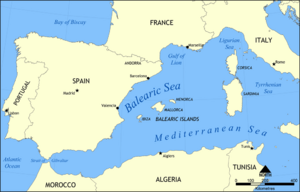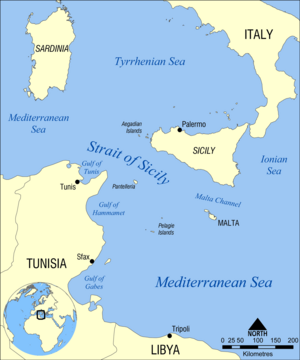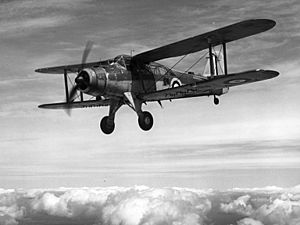Malta convoys facts for kids
Quick facts for kids Malta convoys |
|
|---|---|
| Part of the Battle of the Mediterranean | |

Relief map of the Mediterranean Sea
|
|
| Operational scope | Supply operations |
| Location | Malta |
| Planned by | Mediterranean Fleet RAF Middle East (RAF Middle East Command from 29 December 1941) Merchant Navy Allies |
| Commanded by | Admiral Sir Andrew Cunningham, 1 June 1939 – March 1942 Admiral Sir Henry Harwood, 22 April 1942 – February 1943 |
| Objective | Relief of the Siege of Malta |
| Date | 27 June 1940 – 31 December 1943 |
| Outcome | Allied victory |
| Casualties | 1,600 civilians on Malta 5,700 service personnel on land, sea and in the air Aircraft: 707 Merchant Navy ships: 31 sunk Royal Navy: 1 battleship 2 aircraft carriers 4 cruisers 1 minelayer 20 destroyers/minesweepers 40 submarines unknown number of smaller vessels |
The Malta convoys were a series of important supply missions during World War II. They took place in the Mediterranean Sea from 1940 to 1943. These convoys aimed to deliver vital supplies to the island of Malta. Malta was a British base that faced a long and difficult siege by the Axis powers.
Malta was super important because it was located right in the middle of the Mediterranean. From there, British ships and planes could attack enemy supply routes. These routes were used by the Axis (Germany and Italy) to send supplies to their armies in North Africa. Keeping Malta supplied was a huge challenge. The British risked many ships and lives to get food, fuel, and weapons to the island. The Axis tried hard to stop these convoys and make Malta useless.
British convoys were protected by warships from the Mediterranean Fleet and Force H. Planes from the Fleet Air Arm and Royal Air Force also helped. But Axis forces, including the Italian Regia Aeronautica (Air Force) and Regia Marina (Navy), attacked them. From 1941, the German Luftwaffe (Air Force) and Kriegsmarine (Navy) joined the attacks.
In 1942, the British sent huge groups of warships to protect the convoys. They also used fast warships and even submarines for special supply runs. Fighter planes like Hawker Hurricanes and Supermarine Spitfires were flown to Malta from aircraft carriers. By mid-1942, Axis air attacks were so strong that Malta almost became useless as a base. The Axis even planned to invade Malta, but this plan was later cancelled.
The siege of Malta became easier after the Allies won the Second Battle of El Alamein in October 1942. As the Axis armies retreated, more areas around Malta came within reach of Allied planes. This meant convoys could get air cover almost all the time. By the end of 1942, Malta was receiving supplies much more safely.
Contents
- Why Malta Was So Important
- Key Convoy Operations
- First Year: 1940-1941 Challenges
- Second Year: 1941-1942 Intensification
- Third Year: 1942-1943 Turning the Tide
- Operation MF 3: Heavy Losses
- Operation Spotter: Spitfires Arrive
- Operation MG 1: The Second Battle of Sirte
- Operation Calendar: US Carrier Helps
- Operation Julius (Harpoon and Vigorous): Double Convoy Disaster
- Operation Pedestal: The "Ohio" Arrives
- Operations Stone Age and Crupper: Siege Ends
- Operation Portcullis: Supplies Flow Freely
- The Cost of Victory
- See also
Why Malta Was So Important
Malta's Role in World War II
Malta is a small island, only about 122 square miles (316 square kilometers). It had been a British colony since 1814. In the 1940s, about 275,000 people lived there. But local farms could only feed a third of them. The rest of the food had to be brought in by ships.
Malta was a key stop on the British sea route to India and the Middle East. It was also very close to the Strait of Sicily, a narrow passage between Sicily (Italy) and Tunis (North Africa). This made Malta a perfect base for British planes, ships, and submarines. From Malta, they could attack Axis supply convoys heading to North Africa.
Challenges for Malta in 1942
Because Malta was so active against Axis supplies, it faced heavy air attacks in 1941 and 1942. By July 1942, many fighter planes on the island were destroyed. There was also very little aviation fuel left. This made it hard to send out bombers for attacks.
The situation got worse when Japan entered the war in December 1941. This meant Britain had to send some resources to Asia. Malta was almost completely cut off. Many British warships were sunk in Valletta harbour, Malta's main port. Food, medicine, fuel, and ammunition for the people and soldiers on Malta ran very low. The Axis even planned a big invasion of Malta, called Operation Hercules, but they cancelled it in June 1942.
The Mediterranean War Front
The Allies fought the Western Desert Campaign in North Africa against Italy and Germany. Germany sent its famous Afrika Korps and many planes to the Mediterranean. At first, supplies reached Malta fairly well. From June to December 1940, 21 ships arrived without loss. This built up a seven-month supply reserve.
In 1941, only one merchant ship was lost in three convoy operations to Malta. But from January 1941 to August 1942, 25 out of 46 supply ships were sunk. This meant a lot of valuable ships and planes were needed to protect the convoys. Submarines also made 31 supply runs. Reinforcing Malta's air defenses was also very costly. Aircraft carriers made 19 dangerous trips to deliver fighter planes. From August 1940 to August 1942, 670 Hurricane and Spitfire fighters were flown to Malta.
Key Convoy Operations
First Year: 1940-1941 Challenges
When Italy joined the war in June 1940, Malta became much harder for Britain to supply. British bases in Gibraltar and Egypt were far away. It quickly became clear that air power and land bases were key to winning in the Mediterranean.
Events on land, like battles in Greece and Libya, also affected sea routes. For example, after Britain pushed back the Italian invasion of Egypt in 1940, Germany sent planes and troops to the Mediterranean. This increased the danger for Malta convoys.
Operation Hurry: First Air Reinforcement
In August 1940, the British used an aircraft carrier, HMS Argus, to send 12 Hurricanes to Malta. This was the first "Club Run" to boost Malta's air defense. These special trips continued until planes could fly directly from Gibraltar.
Operation Hats: Big Supply Convoy
In September 1940, the Mediterranean Fleet escorted a fast convoy of three freighters to Malta. They carried 40,000 tons of supplies, including ammunition for Malta's anti-aircraft guns. Italian airbases were attacked to help the convoy.
Operation Judgement: Taranto Attack
In November 1940, five supply ships reached Malta safely from Alexandria. This happened at the same time as the famous British air attack on the Italian fleet at Taranto.
Operation White: A Costly Trip
Another "Club Run" in November 1940 tried to send 12 Hurricanes to Malta. But because of a threat from the Italian fleet, the planes were launched too early. Eight Hurricanes ran out of fuel and crashed into the sea, and seven pilots were lost. This showed how risky these missions were.
Operation Collar: Complex Movements
In November 1940, a complex operation involved convoys from both Alexandria and Gibraltar. Four ships reached Malta safely. This operation also involved a confused sea battle where British and Italian fleets met but did not achieve a clear victory.
Second Year: 1941-1942 Intensification
Operation Excess: First German Attacks
In January 1941, Operation Excess delivered supplies to Malta. This was the first time the German Luftwaffe attacked a Malta convoy. One British cruiser was sunk, and an aircraft carrier was badly damaged.
Operation MC 9: Evading Detection
In March 1941, four ships sailed from Alexandria to Malta. They used indirect routes and bad weather to avoid being spotted by Axis planes. All ships reached Malta, but two were bombed once they were in port.
Operation Dunlop: More Air Reinforcements
In April 1941, HMS Ark Royal flew off 24 Hurricanes to Malta. Other planes like Bristol Blenheims and Beaufighters also flew directly from Gibraltar. This operation showed Malta's value as a base. Just before this, British destroyers based in Malta sank an Axis supply convoy.
Operations Tiger and Splice: Fuel and Fighters
In May 1941, Operation Tiger involved a convoy from Gibraltar to Alexandria, with some ships peeling off for Malta. One merchant ship was lost to mines. Operation Splice delivered 48 Hurricanes to Malta. These operations brought much-needed fuel and fighters to the island.
Operation Substance: A Tough Fight
In July 1941, Operation Substance sent six ships carrying 5,000 soldiers and supplies. It was heavily protected by battleships and aircraft carriers. Italian air attacks were fierce. One cruiser was hit and had to turn back. A destroyer was so badly damaged it had to be sunk. Despite the attacks, the convoy reached Malta, delivering 65,000 tons of supplies.
Operation Halberd: A Major Effort
In September 1941, Operation Halberd was a huge effort. Nine merchant ships carried 81,000 tons of supplies and 2,600 troops from Gibraltar. They were protected by three battleships, an aircraft carrier, and many cruisers and destroyers. Italian air attacks were more skilled this time. One battleship was hit by a torpedo. Another transport ship was torpedoed and had to be sunk. But the rest of the convoy reached Malta, landing 85,000 tons of supplies. This was the last big convoy of 1941.
Operation Perpetual: Ark Royal Sunk
In November 1941, the aircraft carriers Ark Royal and Argus flew off 37 Hurricanes to Malta. Sadly, on November 13, Ark Royal was torpedoed and sank the next day. This was a major loss for the British.
Third Year: 1942-1943 Turning the Tide
Operation MF 3: Heavy Losses
In January 1942, two convoys with two ships each sailed from Alexandria. One ship had mechanical problems and was bombed, forcing it to be sunk. A destroyer was also torpedoed and sunk by a German submarine. Only three freighters reached Malta. This showed the increasing danger.
Operation Spotter: Spitfires Arrive
In March 1942, Operation Spotter brought the first 15 Supermarine Spitfire fighter planes to Malta. These new, faster planes were crucial for defending the island. They immediately flew sorties against German bombers.
Operation MG 1: The Second Battle of Sirte
In March 1942, four ships sailed from Alexandria. This convoy led to the Second Battle of Sirte, a fierce naval battle. Italian and German planes attacked the convoy. The British escorts fought hard, laying smoke screens to hide the ships. Despite heavy attacks, three ships reached Malta. However, unloading was very slow due to constant bombing. Two ships were set on fire before unloading, and only a small amount of supplies were saved.
Operation Calendar: US Carrier Helps
In April 1942, the American aircraft carrier USS Wasp delivered 47 Spitfires to Malta. This was a huge help, but many of the planes were destroyed on the ground by Axis bombing soon after they arrived.
Operation Julius (Harpoon and Vigorous): Double Convoy Disaster
In June 1942, Operation Julius tried to send convoys from both ends of the Mediterranean at the same time. Operation Harpoon, from Gibraltar, had six freighters carrying 43,000 tons of supplies. It faced intense Axis attacks. One cruiser was badly damaged, and one merchant ship was sunk. On June 15, an Italian cruiser force attacked the escort. Many ships were damaged or sunk, including the famous destroyer HMS Bedouin. Only two merchant ships reached Malta, bringing 15,000 tons of supplies.
Operation Vigorous, from Egypt, had eleven merchant ships. It was attacked for four days and threatened by an Italian fleet. It eventually had to turn back. Several British warships and two merchant ships were sunk.
Operation Pedestal: The "Ohio" Arrives
In August 1942, with supplies running very low, the largest convoy yet was assembled for Operation Pedestal. It had 14 merchant ships, including the huge oil tanker SS Ohio. This convoy was protected by 44 warships, including three aircraft carriers and two battleships.
The convoy faced non-stop attacks from Axis planes, torpedo boats, and submarines. Many ships were sunk. But on August 13-15, three merchant ships and the damaged Ohio reached Malta. The Ohio was so badly hit that it broke in two in Valletta Harbour. But most of its vital cargo, especially aviation fuel, was unloaded. The arrival of the Ohio was seen as a miracle by the people of Malta. This convoy delivered enough supplies to last until mid-November and helped save Malta from surrender.
Operations Stone Age and Crupper: Siege Ends
In November 1942, Operation Stone Age brought a convoy of four merchant ships from Alexandria. This time, Allied fighters flying from desert airfields provided much better air cover. All ships arrived safely. This success, along with other supply runs, finally ended the long siege of Malta.
Operation Portcullis: Supplies Flow Freely
In December 1942, Operation Portcullis brought five ships from Port Said. This was the first convoy to arrive without any losses since 1941. Nine more ships arrived by the end of December, bringing huge amounts of fuel and general supplies. This allowed Malta to recover and even increase food rations for its people.
The Cost of Victory
Casualties and Losses
From June 1940 to December 1943, the fight for Malta came at a high price. About 1,600 civilians and 700 soldiers on Malta were killed. The Royal Air Force lost around 900 men and 707 aircraft. The Royal Navy lost 1,700 submariners and 2,200 sailors. About 200 merchant navy men also died.
Out of 110 merchant ship voyages to Malta, 79 arrived. However, three of those were sunk soon after reaching the island. The Mediterranean Fleet lost one battleship, two aircraft carriers, four cruisers, and many destroyers and submarines. Many small ships were also sunk or damaged. The Malta convoys were a true test of courage and determination during World War II.
See also
- Bonner Fellers - a US military officer whose reports were read by the Axis
- Mediterranean U-boat Campaign (World War II)









